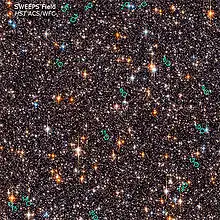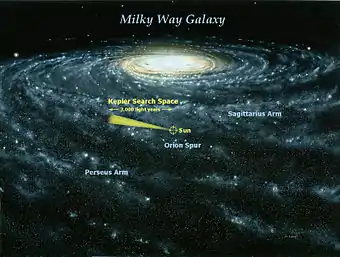Large Interferometer For Exoplanets
Large Interferometer For Exoplanets (LIFE) is a project started in 2017 to develop the science, technology and a roadmap for a space mission to detect and characterize the atmospheres of dozens of warm, terrestrial extrasolar planets. The current plan is for a nulling interferometer operating in the mid-infrared consisting of several formation flying collector telescopes with a beam combiner spacecraft at their center.[1][2][3][4][5][6]
 | |
| Mission type | Exoplanet observation |
|---|---|
| Website | www |
| Mission duration | 5-6 years |
| Main telescope | |
| Type | 4-telescope array with 6:1 baseline ratio, maximum/minimum allowed separation: 600 m / 10 m |
| Diameter | 4 x 2-3.5 m |
| Wavelengths | 4 – 18 μm (mid-infrared) |
| Resolution | spectral: 35 - 50 |
LIFE shall obtain thermal emission spectra with sufficient spectral resolution, wavelength coverage and sensitivity to investigate at least 30 (requirement) / 50 (goal) extrasolar planets with radii between 0.5 and 1.5 Earth radii and receiving between 0.35 and 1.7 times the insolation of the Earth in order to assess their diversity, habitability and search for biomarkers. The sample shall be roughly equally split between planets orbiting late K to early M-type stars and planets orbiting late F to early K-type stars.[7][8]
References
- https://www.life-space-mission.com/
- Atmospheric characterization of terrestrial exoplanets in the mid-infrared: biosignatures, habitability & diversity, Sascha P. Quanz et al.,7 Aug 2019
- Direct imaging of molten protoplanets in nearby young stellar associations, Irene Bonati et al., 18 Nov 2018
- Characterizing the atmosphere of Proxima b with a space-based mid-infrared nulling interferometer, D. Defrère et al., 26 Jul 2018
- Space-based infrared interferometry to study exoplanetary atmospheres, D. Defrère et al., 21 Dec 2018
- Simulating the Exoplanet Yield of a Space-based MIR Interferometer Based on Kepler Statistics, J. Kammerer, S. P. Quanz, 17 Oct 2017
- Presentation at EPSC 2020 Angerhausen, EPSC 2020 talk
- The LIFE mission: a mid-infrared space interferometer to study the diversity of terrestrial exoplanets Daniel Angerhausen, Sascha Quanz, and the LIFE initiative, EPSC 2020
Further reading
- Exoplanet science with a space-based mid-infrared nulling interferometer, Sascha P. Quanz, Jens Kammerer, Denis Defrère, Olivier Absil, Adrian M. Glauser, Daniel Kitzmann, 9 Aug 2018

